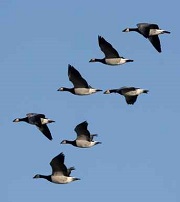Lessons from Geese
-Bill Abbott, SMART Recovery® Facilitator
 SMART Recovery is a wonderful program that emphasizes self-management and self-empowerment. For this it offers tools based on sound and often evidence-based science—mostly clinical psychology but some neuroscience as well.
SMART Recovery is a wonderful program that emphasizes self-management and self-empowerment. For this it offers tools based on sound and often evidence-based science—mostly clinical psychology but some neuroscience as well.
With all the emphasis on “self”—almost a do-it-yourself program—we often lose sight of another powerful feature of SMART—the mutual support groups in which all this is developed and promoted.
We like company, lots of the time—especially with like-minded people, hence the shelter and safety and power of a mutual support group complex. Like-minded people all in a room together discussing a common issue. A place were the afflicted can relax, become honest and open with their issues, without worry of judgment. This is present in both 12-steps groups and in SMART Recovery groups.
In my opinion SMART groups have the added feature of interactive discussion, promoting the feelings of like-mindedness and that “we are all in this together”. We are all united in spirit and intent to find relief for ourselves, and in so doing share that with others. All this falls under the concept of Compassion.
Many state that they go to 12-step meetings for “spirituality“ and attend SMART meetings for the tools and solutions. The implication is that there is no spirituality at SMART.
I guess it depends on the definition of the word. I find there are as many definitions as there are definers.
I believe there is a form of spirituality in SMART, in the interactive communications that happen in the spirit of being together, that brings us peace, clarity, safety and power.
Our friend and colleague Kristina shared the following with me before her untimely death—and it expresses it well.
This autumn when you see geese heading south for the winter and flying along in a “V” formation, you might consider what science has discovered as to why they fly that way. As each bird flaps its wings, it creates ‘uplift’ for the bird immediately following. By flying in a “V” formation, the whole flock adds at least 70% greater flying range than if a bird flew on its own.
People who share a common direction and a sense of community can get where they are going more quickly and easily, because they are traveling on the thrust of each other. When a goose falls out of formation, it suddenly feels the drag and resistance of trying to go it alone and quickly gets back into formation to take advantage of the lifting power of the bird in front.
If we have as much sense as a goose, we will stay in formation with those who are headed in the same way that we are.
When the lead goose gets tired, it rotates back in the wing and another goose flies point. It is sensible to take turns doing demanding jobs with people (or with geese flying south). Geese honk from behind to encourage those up front to keep up their speed. Finally, and this is important, when a goose gets sick or is wounded by gunshots, and falls out of formation, two other geese fall out with that goose and follow it down to lend a helping hand for protection. They stay with the fallen goose until it is able to fly or until it dies. Only then do they launch out on their own or with another formation to catch up with their group.
If we have the sense of a goose, we would stand by each other like that.
May we be grateful for this otherwise hidden benefit of being together in a room sharing support in a common goal—Recovery.
Bill Abbott is a long time SMART volunteers who, in addition to numerous other SMART volunteer activities, facilitates weekly SMART meetings in the Boston area as well as online.
